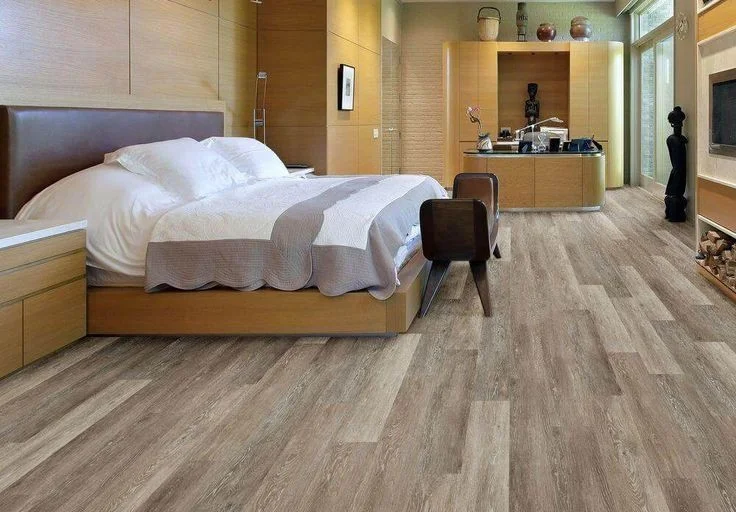Hardwood floors bring a timeless elegance to any home. But daily life, from children playing to furniture being moved, can lead to wear and tear. While some minor issues can be a quick weekend fix, others may signal deeper problems that require a professional touch.
This guide will walk you through common hardwood flooring issues, explaining what causes them and how you can fix them. We'll cover DIY techniques for simple repairs and explain when it's time to call in the experts. By understanding these repair options, you can keep your floors looking beautiful for years to come.
Common Hardwood Floor Problems
Hardwood floors are durable, but they aren't indestructible. Over time, you might notice a few common problems emerge.
- Splits and Cracks: These are fissures that appear along the grain of the wood. Small, hairline cracks are often cosmetic, but larger splits can worsen over time.
- Gaps: Noticeable spaces between your floorboards are common. They often appear and disappear with seasonal humidity changes as the wood expands and contracts.
- Buckling: This is when floorboards lift from the subfloor, creating a hump or peak. It's almost always caused by excessive moisture.
- Cupping: Cupping occurs when the edges of a board are higher than its center. This "cupped" appearance is also a result of a moisture imbalance.
- Warping: A more severe form of distortion, warping involves twisting and bending of the planks. Like buckling, it's a sign of significant moisture issues.
- Scratches: From pets' claws to dragged furniture, scratches are one of the most frequent types of damage. They can be surface-level or deep gouges.
- Loose Planks: A plank that moves or squeaks underfoot has likely become detached from the subfloor.
Tools and Materials for DIY Repairs
For minor hardwood floor repairs, having the right tools on hand makes all the difference. You can find these at most hardware stores.
- Wood Filler or Putty: Ideal for filling small cracks, holes, and gouges. Choose a color that closely matches your floor's finish.
- Finish Nails: Thin nails that are useful for securing loose planks or the edges of a split board.
- Wood Adhesive: A strong glue designed for bonding wood to the subfloor is perfect for reattaching loose planks.
- Touch-Up Kits: These often come with markers and filler sticks in various shades to conceal minor scratches and blemishes.
- Wood Stain Markers: A simple way to color in light scratches on a stained floor.
Step-by-Step Repair Guides
With the right tools, you can confidently tackle many common repairs yourself.
Fixing Small Cracks and Splits
For minor cracks, wood putty is your best friend.
- Clean the cracked area thoroughly to remove any dust or debris.
- Apply a small amount of wood putty with a putty knife, pressing it firmly into the crack.
- Wipe away any excess putty before it dries.
- If the split is at the edge of a board, you can drive a finish nail at an angle through the split to secure it to the subfloor for extra stability.
Addressing Gaps Between Planks
Seasonal gaps that appear in winter often close up on their own in the summer. If gaps persist year-round, you can fill them.
- For very thin gaps, you can use a color-matched wood filler. Apply it carefully between the boards and wipe away the excess.
- Avoid overfilling, as the wood will need space to expand when humidity levels rise again. For larger, more stubborn gaps, consulting a professional is the best course of action.
Repairing Scratches
The method for fixing scratches depends on their depth.
- For surface-level scratches: A touch-up kit with a wood marker or a specialized crayon can often make the scratch disappear. Simply color in the scratch, wipe off the excess, and buff the area.
- For deeper scratches: You may need to use a wood filler stick. Press the filler into the scratch, remove the excess, and allow it to dry before lightly sanding and applying a matching finish.
Reattaching Loose Planks
A squeaky or shifting plank can be annoying, but it's often a simple fix.
- Using Nails: Drill small pilot holes through the loose plank and drive finish nails into the subfloor at an angle.
- Using Adhesive: For a stronger bond, you can inject wood adhesive into the space beneath the loose plank using a syringe. Place a heavy weight on the board while the adhesive cures.
When to Call a Professional
While DIY repairs are great for minor issues, some problems demand professional expertise. Attempting to fix severe damage without the right skills can often make the situation worse. Call a professional for:
- Buckling and Warping: These are clear signs of a serious moisture problem. A professional can identify the source of the moisture, repair the subfloor if needed, and replace the damaged boards.
- Persistent Gaps: If gaps in your flooring don't resolve with seasonal changes or are unusually large, an expert can assess whether this is due to an installation issue or environmental factors.
- Large Cracks or Widespread Damage: When damage is extensive, refinishing or plank replacement may be necessary. Professionals have the tools and experience to perform seamless repairs, often blending new flooring with the old so perfectly that the repair is unnoticeable.
Keep Your Floors Looking Their Best
The most effective way to handle hardwood floor repairs is to prevent damage in the first place.
- Control Humidity: Maintain a stable indoor humidity level (ideally between 35-55%) year-round using a humidifier or dehumidifier. This minimizes the wood's natural expansion and contraction.
- Regular Maintenance: Sweep or vacuum your floors regularly to remove abrasive dirt and grit. Clean up spills immediately to prevent moisture damage.
- Protect High-Traffic Areas: Use area rugs and runners in hallways and entryways. Place felt pads on the legs of all furniture to prevent scratches.
Why Choose Creative Floors Aurora?
For repairs that are beyond a simple DIY fix, you need a team you can trust. Creative Floors Aurora has been serving the Chicago metropolitan area since 2007, building a reputation for high-quality craftsmanship and customer satisfaction.
Our expertise lies in comprehensive hardwood repair and refinishing. We specialize in making damaged areas look "seamless with the rest of the floor," as one of our clients noted. Our team is skilled at lacing in new boards and matching stains and finishes to create a flawless result. We follow a strict 10-step process for every project, including mandatory inspection points to ensure the highest quality before moving forward. From containing dust to arriving on time, our professional crews are dedicated to making the repair process as smooth as possible for you.
Your Next Steps
Addressing hardwood floor issues promptly can prevent them from becoming bigger, more expensive problems. Whether it's a small scratch you can fix yourself or significant damage requiring expert attention, taking action is key to preserving the beauty and value of your floors.
If you're facing a repair that seems too big to handle, don't hesitate to seek professional help. The team at Creative Floors Aurora is ready to provide a thorough assessment and restore your floors to their original glory.
Frequently Asked Questions About Hardwood Reparis
The most frequent hardwood flooring issues include splits and cracks along the wood grain, gaps between floorboards, scratches from pets or furniture, and loose planks that squeak or move underfoot. You may also notice moisture-related problems like buckling (boards lifting from the subfloor), cupping (edges higher than the center), or warping (twisting and bending of planks).
Buckling, cupping, and warping are all clear signs of moisture-related damage. Buckling creates humps or peaks where boards lift from the subfloor, cupping makes the edges of boards higher than their centers, and warping involves severe twisting and bending of planks. These issues typically indicate significant moisture problems that require professional assessment.
Yes, seasonal gaps are completely normal and often appear during winter months when humidity levels drop, causing wood to contract. These gaps typically close up on their own during summer when humidity increases. However, if gaps persist year-round or are unusually large, this may indicate an installation issue or environmental problem that needs professional evaluation.
For minor DIY hardwood repairs, you'll need wood filler or putty (in a color matching your floor), finish nails for securing loose planks or split boards, and wood adhesive designed for bonding wood to subfloors. Touch-up kits with markers and filler sticks, plus wood stain markers for light scratches, are also essential for cosmetic repairs.
Wood filler or putty is ideal for filling small cracks, holes, and gouges in the wood surface. Choose a color that closely matches your floor's finish. Wood adhesive, on the other hand, is designed for structural repairs specifically for reattaching loose planks to the subfloor by creating a strong bond between the wood and subflooring.
Yes, many scratches can be repaired with DIY methods. For surface-level scratches, use a wood marker or specialized crayon from a touch-up kit to color in the scratch, then wipe off excess and buff the area. For deeper scratches, you'll need a wood filler stick press it into the scratch, remove excess, let dry, then lightly sand and apply matching finish.
Call a professional for buckling and warping (signs of serious moisture problems), persistent gaps that don't resolve seasonally, large cracks, or widespread damage. Professionals can identify moisture sources, repair subfloors if needed, and perform seamless plank replacements that blend perfectly with existing flooring.
Small, hairline cracks along the wood grain are often cosmetic and can be filled with wood putty. However, larger splits that continue to worsen over time, or cracks that affect the structural integrity of the plank, should be evaluated by a professional. When in doubt, it's better to consult an expert to prevent further damage.
This depends on the extent of the damage. Minor moisture issues caught early may be repairable, but severe buckling, cupping, or warping often requires professional assessment and potentially plank replacement. A professional can determine if the subfloor has been affected and needs repair before new flooring can be installed.
Maintain stable indoor humidity levels between 35-55% year-round using humidifiers or dehumidifiers to minimize wood expansion and contraction. Sweep or vacuum regularly to remove abrasive dirt, clean up spills immediately, use area rugs in high-traffic areas, and place felt pads on furniture legs to prevent scratches.
Wood is a natural material that expands and contracts with changes in moisture levels. When humidity fluctuates significantly, it causes gaps, splits, and other structural issues. Maintaining consistent humidity levels prevents most seasonal movement and reduces the risk of cracks, gaps, and moisture-related damage like cupping and buckling.
Need professional hardwood floor repair in the Chicagoland area? Creative Floors Aurora has been providing expert hardwood repair and refinishing services since 2007. Contact us for a free assessment or call (630) 537-1047 to schedule your in-home estimate.

